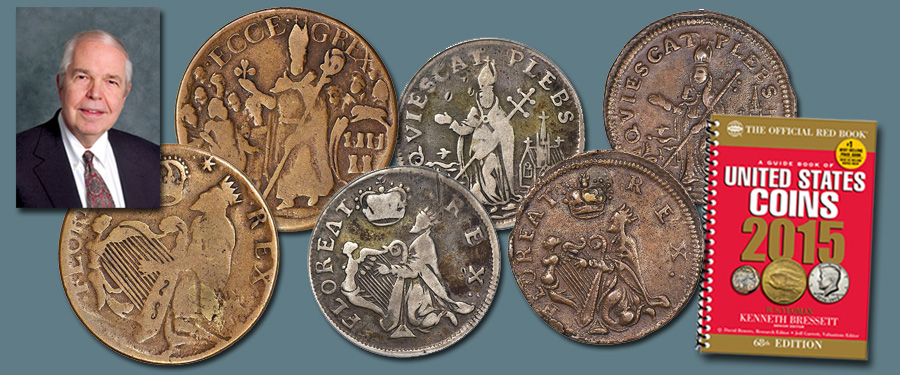
I continue my tour of A Guide Book of United States Coins. You can follow along in the 2015 edition, beginning on page 40. Seeking coins relating to colonial America has been a popular pursuit for many years. Today the Colonial Coin Collectors Club (C4) provides a meeting place for enthusiasts. Check out their website and learn more. This group was founded in 1993 by Michael Hodder and has grown rapidly since.
The coins known as St. Patrick or Mark Newby coinage were produced in Ireland and distributed in the United States. Accordingly, they are foreign issues from a technical viewpoint, but as many were used on this side of the Atlantic, in addition to those circulating in Ireland, they have been adopted by American collectors. Opinions vary concerning their status.
In 1881 in his study of New Jersey copper coins (the extensive series made later from 1786 to 1788) Dr. Edward Maris included mention of these early pieces as well. In recent decades studies by die varieties have been conducted by several people and have been published in the C4 Newsletter and in The Colonial Newsletter, the latter published by the American Numismatic Society.
Mark Newby, a shopkeeper in Dublin, Ireland, in the 1670s, moved to Bellicane in County Wicklow and from there sailed to America, landing in West Jersey (today’s New Jersey) arriving on November 19, 1681, in company with others. He brought with him a quantity of coins of two sizes, today called the farthing (or one-fourth of a penny) and half penny, although they bore no stated value. Newby became a member of the West Jersey legislature, and on May 8, 1682, influenced the passage of an act which provided:
“That Mark Newby’s half-pence, called Patrick’s [no mention of Saint] halfpence, shall from and after this said eighteenth instant, passed for halfpence current pay of this Province provided that he, the said Mark, gives sufficient security to the speaker of the house for the use of the General Assembly from time to time being, that he, the said Mark, his executors and administrators, shall and will change the said halfpence for any pay equivalent, upon demand, and provided that no person or persons be hereby obliged to take more than five shillings in one payment.”
The St. Patrick’s coppers were minted in two weights and diameters, the smaller being far the more common today. Normally in coinage in England, a farthing was half the weight of a halfpenny, but this relationship does not hold true for the St. Patrick’s pieces. It could be that both sizes were valued at a halfpenny, per the legislative act. Another mystery.
The obverse of the “farthing” depicts King David, kneeling and playing an Irish harp, with a crown above. During the coinage process, these copper coins had a small piece of brass inserted at the crown point to give it a golden appearance. The reverse shows St. Patrick standing with a church to the right. The obverse design of the “halfpenny” is similar to that of the “farthing.” The reverse of the halfpenny shows St. Patrick standing, surrounded by a group of followers and with a shield. St. Patrick is the ancient Episcopal patron of Ireland. He is, of course, remembered in America today on March 17, a time of celebration by citizens with a tie to Ireland, plus a lot of others as well.
The coinage must have been extensive, as over 140 die varieties of the smaller denomination have been identified, plus nine of the larger. Many of the smaller coins have been found by metal detectorists in New Jersey, reflecting that these must have been the most common denomination. None of the larger size have been found in this manner. It is therefore reasonable to suggest that the smaller size coins were intended to be of halfpenny value. As is true of so many colonial issues, opinions are divided.
Today, these coins are readily collectible. One of each type in copper can be obtained in Very Good grade in the hundreds of dollars, and in Fine somewhat over $1,000. In addition, there are die varieties that are scarce, and some impressions exist in silver. The silver coins listed in the Guide Book do not seem to have been used in America but may have been patterns or special pieces.
I will continue next week.





